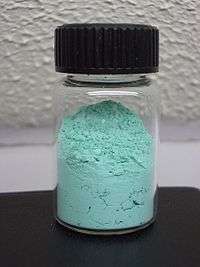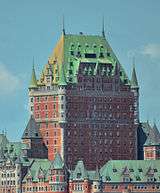Basic copper carbonate
 | |
| Names | |
|---|---|
| IUPAC name
Dicopper carbonate dihydroxide | |
| Other names
copper carbonate hydroxide, cupric carbonate, copper carbonate | |
| Identifiers | |
| 12069-69-1 | |
| 3D model (Jmol) | Interactive image |
| ChemSpider | 23796 |
| ECHA InfoCard | 100.013.338 |
| PubChem | 25503 |
| |
| |
| Properties | |
| Cu2(OH)2CO3 | |
| Molar mass | 221.116 g/mol |
| Appearance | green powder |
| Density | 4 g/cm3 |
| Melting point | 200 °C (392 °F; 473 K) |
| Boiling point | 290 °C (554 °F; 563 K) decomposes |
| insoluble | |
| Solubility product (Ksp) |
7.08·10−9 |
| Thermochemistry | |
| Std molar entropy (S |
88 J/mol·K |
| Std enthalpy of formation (ΔfH |
−595 kJ/mol |
| Hazards | |
| Safety data sheet | Oxford MSDS |
| GHS pictograms |  [1] [1] |
| GHS signal word | Warning |
| H302, H315, H319, H335[1] | |
| P261, P305+351+338[1] | |
| EU classification (DSD) |
|
| R-phrases | R22, R36/37/38 |
| S-phrases | S26, S36 |
| Lethal dose or concentration (LD, LC): | |
| LD50 (median dose) |
159 mg/kg (rat, oral) |
| US health exposure limits (NIOSH): | |
| PEL (Permissible) |
TWA 1 mg/m3 (as Cu)[2] |
| REL (Recommended) |
TWA 1 mg/m3 (as Cu)[2] |
| IDLH (Immediate danger) |
TWA 100 mg/m3 (as Cu)[2] |
| Except where otherwise noted, data are given for materials in their standard state (at 25 °C [77 °F], 100 kPa). | |
| | |
| Infobox references | |
Basic copper carbonate is a chemical compound, more properly called copper(II) carbonate hydroxide. It is an ionic compound (a salt) consisting of the ions copper(II) Cu2+
, carbonate CO2−
3, and hydroxide HO−
.
The name most commonly refers to the compound with formula Cu
2CO
3(OH)2. It is a green crystalline solid that occurs in nature as the mineral malachite. It has been used since antiquity as a pigment, and it is still used as such in artist paints, sometimes called vertiter, green bice, or mountain green.
Sometimes the name is used for Cu
3(CO
3)2(OH)2, a blue crystalline solid also known as the mineral azurite. It too has been used as pigment, sometimes under the name mountain blue or blue verditer.
Both malachite and azurite can be found in the verdigris patina that is found on weathered brass, bronze, and copper. The composition of the patina can vary, in a maritime environment depending on the environment a basic chloride may be present, in an urban environment basic sulfates may be present.[3]
This compound is often improperly called (even in chemistry articles) copper carbonate, cupric carbonate, and similar names. The true (neutral) copper(II) carbonate CuCO3 is not known to occur naturally.[4] It is decomposed by water or moisture from the air, and was synthesized only in 1973 by high temperature and very high pressures.[5]
Preparation
Basic copper carbonate is prepared by combining aqueous solutions of copper(II) sulfate and sodium carbonate at ambient temperature and pressure. Basic copper carbonate precipitates from the solution, with release of carbon dioxide CO
2:[6]
- 2 CuSO4 + 2 Na2CO3 + H2O → Cu2(OH)2CO3 + 2 Na2SO4 + CO2
Basic copper carbonate can also be prepared by reacting aqueous solutions of copper(II) sulfate and sodium bicarbonate at ambient conditions. Basic copper carbonate precipitates from the solution, again with release of carbon dioxide:
- 2 CuSO4 + 4 NaHCO3 → Cu2(OH)2CO3 + 2 Na2SO4 + 3 CO2 + H2O

Reactions
Basic copper carbonate is decomposed by acids, such as solutions of hydrochloric acid HCl, into the copper(II) salt and carbon dioxide.
"Copper carbonate" was the first compound to be broken down into several, separate elements (copper, carbon, and oxygen). It was broken down in 1794 by the French chemist Joseph Louis Proust (1754–1826). When heated, it thermally decomposes to form CO2 and CuO, cupric oxide, a black solid.
The basic copper carbonates, malachite and azurite, both decompose forming CO2 and CuO, cupric oxide.[7]
Uses
Both malachite and azurite basic copper carbonates have been used as pigments.[8] It has also been used in some types of make-up, like lipstick, although it can also be toxic to humans. It also has been used for many years as an effective algaecide in farm ponds and in aquaculture operations.
References
- 1 2 3 Copper(II) carbonate basic
- 1 2 3 "NIOSH Pocket Guide to Chemical Hazards #0150". National Institute for Occupational Safety and Health (NIOSH).
- ↑ Encyclopedia Of Corrosion Technology (Google eBook), Philip A. Schweitzer P.E.; CRC Press, 2004, ISBN 08247-4878-6
- ↑ Holleman, A. F.; Wiberg, E. (2001), Inorganic Chemistry, San Diego: Academic Press, p. 1263, ISBN 0-12-352651-5
- ↑ Seidel, H.; Ehrhardt, H.; Viswanathan, K.; Johannes, W. (1974). "Darstellung, Struktur und Eigenschaften von Kupfer(II)-Carbonat". Zeitschrift für anorganische und allgemeine Chemie. 410 (2): 138–148. doi:10.1002/zaac.19744100207. ISSN 0044-2313.
- ↑ Jack Reginald Irons Hepburn (1927): "The chemical nature of precipitated basic cupric carbonate". Article CCCLXXXVI, Journal of the Chemical Society (Resumed), volume 1927, pages 2883-2896. doi:10.1039/JR9270002883
- ↑ Brown, I.W.M.; Mackenzie, K.J.D.; Gainsford, G.J. (1984). "Thermal decomposition of the basic copper carbonates malachite and azurite". Thermochimica Acta. 75 (1-2): 23–32. doi:10.1016/0040-6031(84)85003-0. ISSN 0040-6031.
- ↑ Valentine Walsh, Tracey Chaplin, Pigment Compendium: A Dictionary and Optical Microscopy of Historical Pigments, 2008, Routledge, ISBN 978-0-7506-8980-9
External links
| Wikimedia Commons has media related to Copper(II) carbonate. |
| H2CO3 | He | ||||||||||||||||
| Li2CO3, LiHCO3 |
BeCO3 | B | C | (NH4)2CO3, NH4HCO3 |
O | F | Ne | ||||||||||
| Na2CO3, NaHCO3, Na3H(CO3)2 |
MgCO3, Mg(HCO3)2 |
Al2(CO3)3 | Si | P | S | Cl | Ar | ||||||||||
| K2CO3, KHCO3 |
CaCO3, Ca(HCO3)2 |
Sc | Ti | V | Cr | MnCO3 | FeCO3 | CoCO3 | NiCO3 | CuCO3 | ZnCO3 | Ga | Ge | As | Se | Br | Kr |
| Rb2CO3 | SrCO3 | Y | Zr | Nb | Mo | Tc | Ru | Rh | Pd | Ag2CO3 | CdCO3 | In | Sn | Sb | Te | I | Xe |
| Cs2CO3, CsHCO3 |
BaCO3 | Hf | Ta | W | Re | Os | Ir | Pt | Au | Hg | Tl2CO3 | PbCO3 | (BiO)2CO3 | Po | At | Rn | |
| Fr | Ra | Rf | Db | Sg | Bh | Hs | Mt | Ds | Rg | Cn | Nh | Fl | Mc | Lv | Ts | Og | |
| ↓ | |||||||||||||||||
| La2(CO3)3 | Ce | Pr | Nd | Pm | Sm | Eu | Gd | Tb | Dy | Ho | Er | Tm | Yb | Lu | |||
| Ac | Th | Pa | UO2CO3 | Np | Pu | Am | Cm | Bk | Cf | Es | Fm | Md | No | Lr | |||